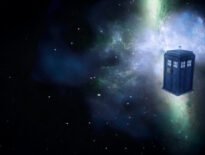It’s with great sadness that we confirm the passing of Doctor Who legend, Chris Achilléos. The painter and illustrator died of a stroke, aged 74, earlier this week.
Of course, Doctor Who fans will know him best for his artwork on the covers of the much-loved Target novels.
Throughout a career spanning five decades, he remained one of the most respected and in demand artists in his field. His signature style combined vivid colours, minute detailing, and an innovative blend of historical, psychedelic, and comic book influences.
Although much of his work was produced on commission, to be miniaturised and serve as book covers, album covers, and film posters, Achilléos produced all his canvasses at large scale, which allowed him to showcase his rare technical skill, refined during his studies of Scientific and Technical Drawing.
He earned the attention of George Lucas, who hired him as a conceptual artist for the visual-effects showpiece Willow; it was a position Achilléos had previously held on the production of the cult classic Heavy Metal, starring John Candy and Harold Ramis.
Even away from Target, his work has adorned hundreds of books, for authors such as Robert E Howard, Edgar Rice Burroughs and Michael Moorcock.





In the worlds of Twelfth Doctor Peter Capaldi, a guest at the opening of a 2016 exhibition of Achilléos’ Doctor Who artwork:
“Chris Achilléos artwork perfectly captures the action packed spirit of 1970s Doctor Who. It’s like he invented it himself.”
Lavishly detailed, with psychedelic overtones and an unapologetically pulpy sensibility, Achilléos’ work both reproduced and reinterpreted the eccentric energy of the show’s classic era, defining a generation’s image of the Doctor and his adventures in the days before repeats or VHS recordings.
From the depths of outer space to the realms of fantasy, Achilléos’ subject matter was a far cry from his childhood in rural Cyprus, during the last days of British rule. He moved to England in his early teens, along with three siblings and widowed mother. He spoke no English and described himself as an introvert who sought solace from prejudice in his art.

Lacking the money for art supplies, he produced his earliest sketches on the back of wallpaper and on paper donated by a local butcher. Having always fiercely maintained his rights over his work, retaining wherever possible the original canvasses, his professional pieces have become highly sought after, and adorn the walls of collectors the world over. In fact, I have cherished prints of some of his work, bought during my last visit to the Doctor Who Experience. They really are something special.
Chris leaves behind a wife, two daughters, and two grandsons. Our thoughts go to his family and friends.


